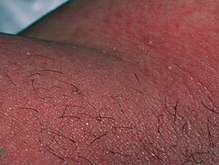Acute generalized exanthematous pustulosis
| Acute generalized exanthematous pustulosis | |
|---|---|
| Other names | Toxic pustuloderma, pustular drug eruption |
 | |
| Acute generalized exanthematous pustulosis | |
| Specialty | Dermatology |
Acute generalized exanthematous pustulosis (AGEP) (also known as pustular drug eruption and toxic pustuloderma) is a rare skin reaction that in 90% of cases is related to medication.
AGEP is characterized by sudden skin eruptions that appear on average five days after a medication is started. These eruptions are
Signs and symptoms
AGEP is an acute drug eruption characterized by numerous small, primarily non-follicular, sterile skin
Rare cases of lung and bone marrow involvement have also been reported to complicate AGEP.[3][7] However, involvement of these organs typically resolve along with the skin eruptions. AGEP typically shows a mild course: usually, it is not associated with life-threatening complicates although superinfections of skin lesions may be serious or even life-threatening. AGEP has a mortality rate of less than 5%.[2][7][8]
Cause
About 90% of AGEP reactions are associated with medications. The remaining cases of AGEP have been associated with infective and other agents.[7]
Medicines
The most frequently reported drugs that have been associated with the development of AGEP include
- cephalexin, cefepime, cefoxitin, cefazolin, various sulfonamides, various quinolones, vancomycin, levofloxacin, imipenem, meropenem, pristinamycin
- Antifungals: Terbinafine, ketoconazole, fluconazole
- Anti-inflammatories: Aspirin, celecoxib
- Other agents: Hydroxychloroquine (an antimalarial agent), diltiazem (a calcium channel blocker), omeprazole (a proton-pump inhibitor), clenbuterol (a decongestant, bronchodilator), hydroxyzine[12] (An antihistamine medication), and clopidogrel (an indirectly acting platelet inhibitor)
Microbe infections
Infections with
Other agents
Herbal medications, spider bites,
Pathophysiology
Like other drug-induced SCARs disorders, AGEP is a
AGEP also differs from the other SCARs disorders in respect to the level of evidence supporting the underlying mechanism by which a drug or its metabolite stimulates CD8+ T or CD4+ T cells. Studies indicate that the mechanism by which a drug or its metabolites accomplishes this stimulation involves subverting the
Variations in
In rare cases, the development of AGEP has been reported to occur in individuals with
Diagnosis
The diagnosis of AGEP may be forthright in typical cases in which an individual: has taken a drug known to cause the disorder; develops multiple sterile
Several tests have been proposed to be useful for supporting the diagnosis of and/or implicating a particular drug as the cause of AGEP particularly in individuals who develop skin lesions while taking multiple drugs. These include
Classification
The disorder is classified in the group of
Treatment
The treatment of AGEP begins with the immediate cessation of the offending drug. For individuals developing AGEP while taking multiple drugs, non-essential drugs should be discontinued and essential drugs should be replaced by chemically unrelated drugs that are used as alternatives to the discontinued drug(s). In cases of multiple drug intake, skin and/or in vitro testing may be of some use in identifying the offending drug. Beyond identifying and discontinuing the offending drug, individuals with mild symptoms may require no further treatment. Those troubled by more significant symptoms such as itching or fever may require
See also
- List of skin conditions
- Skin lesion
- Pustulosis
References
- ISBN 0-7216-2921-0.: 124
- ^ S2CID 333724.
- ^ S2CID 21325754.
- S2CID 205434868.
- ^ PMID 28345177.
- ISBN 978-1-4160-2999-1.
- ^ PMID 27472323.
- ^ S2CID 9506967.
- ^ PMID 26783390.
- ^ PMID 26354880.
- ^ PMID 20548906.
- ^ "HYDROXYZINE HYDROCHLORIDE tablet". Daily Med. U.S. National Library of Medicine. Retrieved 25 October 2020.
- PMID 27075126.
- ^ "Acute generalised exanthematous pustulosis | DermNet NZ". dermnetnz.org. Retrieved 2021-01-14.
- S2CID 46796285.
- PMID 27960170.
- S2CID 9183824.
- PMID 28256714.
- ^ S2CID 4436573.
- PMID 29226159.
- ^ Canadian Medical Association Journal, September 15, 2009, pp 393-396
